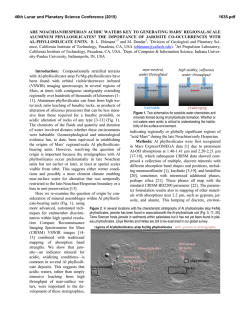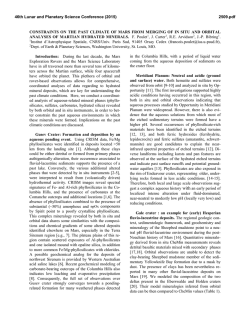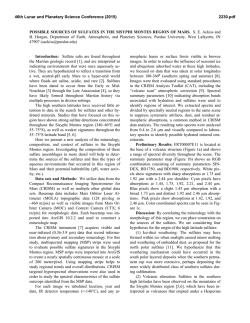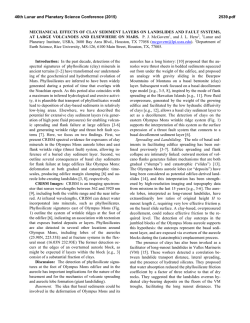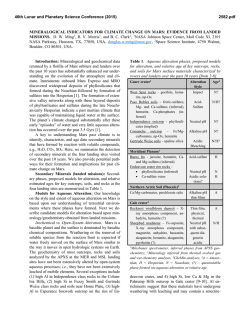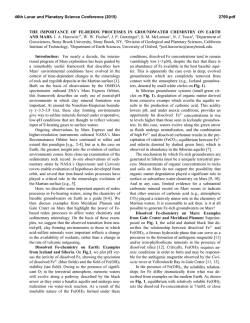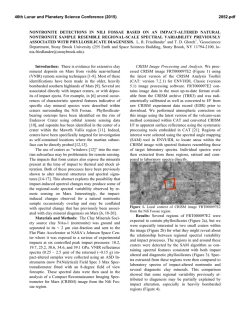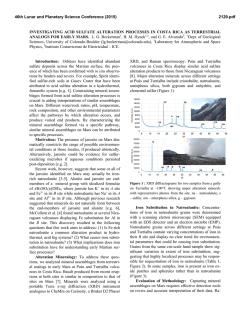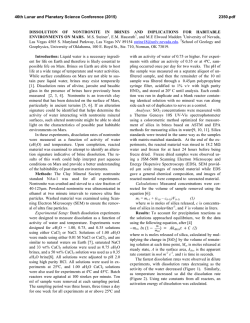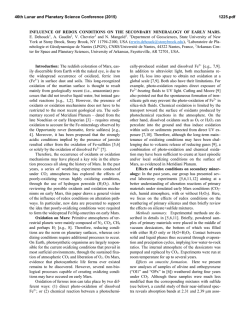
SULFATE MINERAL FORMATION FROM ACID - USRA
46th Lunar and Planetary Science Conference (2015) 2857.pdf SULFATE MINERAL FORMATION FROM ACID-WEATHERED PHYLLOSILICATES: IMPLICATIONS FOR THE AQUEOUS HISTORY OF MARS. P. I. Craig1, D. W. Ming1, E. B. Rampe2, R. V. Morris1; 1NASA Johnson Space Center, 2101 NASA Parkway, Houston, TX 77058; 2Aerodyne Industries, Jacobs JETS Contract, NASA JSC, [email protected]. Introduction: Phyllosilicates on Mars are thought to have formed under neutral to alkaline conditions during Mars’ earliest Noachian geologic era (~ 4.1-3.7 Gya) [e.g. 1]. Sulfate formation, on the other hand, requires more acidic conditions which are thought to have occurred later during Mars’ Hesperian era (~ 3.73.0 Gya) [e.g. 1]. Therefore, regions on Mars where phyllosilicates and sulfates are found in close proximity to each other provide evidence for the geologic and aqueous conditions during this global transition. Both phyllosilicates and sulfates form in the presence of water and thus give clues to the aqueous history of Mars and its potential for habitability. Phyllosilicates that formed during the Noachian era may have been weathered by the prevailing acidic conditions that characterize the Hesperian. Therefore, the purpose of this study is to characterize the alteration products resulting from acid-sulfate weathered phyllosilicates in laboratory experiments. This study focuses on two phyllosilicates commonly identified with sulfates on Mars: nontronite and saponite [2]. We also compare our results to observations of phyllosilicates and sulfates on Mars to better understand the formation process of sulfates in close proximity to phyllosilicates on Mars and constrain the aqueous conditions of these regions on Mars. Experimental and Analytical Techniques: Phyllosilicate samples were obtained from the Clay Minerals Society’s Source Clay Respository: NAu-1 (Canontronite) and SapCa-1 (Ca-saponite). Samples were ground and sieved to a grain size < 53 μm and placed inside Parr hydrothermal vessels. H2SO4 of concentrations from 0.01-1.0 M was added such that the waterrock ratio (WR) was ~50 and ~25. The vessels were then sealed and heated to 100°C for 72 hrs. The vessels were then placed in a freezer for ~1 hr until completely cooled. The liquid sample was gently pipetted off and the remaining solid sample was placed back into the oven at ~95°C until completely dry. Samples were analyzed using X-ray diffraction (XRD), near-infrared (NIR) reflectance spectroscopy and scanning electron microscopy (SEM). XRD patterns were obtained between 4-80° 2θ using CoKα radiation. NIR spectra were collected from 1.0-2.5 μm for comparison to CRISM data. Results and Discussion: XRD patterns of acidtreated nontronite showed a structural collapse of the phyllosilicate layers with increasing acid concentration by the decrease in intensity and shift of the 001 peak (Fig. 1). Bassanite (CaSO4·0.5H2O) formed in nontronite weathered in 0.1 M H2SO4 at WR = 50 from the extraction of interlayer Ca (Fig. 1). While nontronite was more stable under lower WR conditions (001, 060 and 02l peaks still present), the entire original sample was eventually weathered to anhydrite (CaSO4) and rhomboclase in 1.0 M H2SO4 at WR = 50 and gypsum (CaSO4·2H2O) and rhomboclase at WR = 25. This showed a change in the hydration state of the sulfates with changing acid concentration. A small “hump” feature is also evident in the 1.0 M samples indicating an amorphous (likely silicate) phase. Figure 1: XRD patterns of acid-weathered nontronite. All unmarked peaks in the 1.0 M samples are rhomboclase. Both bassanite and anhydrite formed in saponite treated at WR = 25 with hexahydrite and kieserite, however, only hexahydrite (MgSO4·6H2O) and kieserite (MgSO4·H2O) formed in the WR = 50 samples (Fig. 2), again, showing differences in the hydration state of the sulfates formed with changing acid concentration. Additionally, several silicate phases were identified in the WR = 25 samples, including quartz, diopside and K-feldspar (Fig. 2). These were likely contaminants in the original sample whose relative abundance increased with the dissolution of the clay mineral. Near-infrared reflectance spectra of the weathered samples showed a decrease in hydration band intensity and a shift or disappearance of the metal-OH bands (Figs. 3,4) indicating the dehydration and dissociation of the octahedral layers with increased acid weathering. Additionally, the slope of the spectrum gradually be- 46th Lunar and Planetary Science Conference (2015) came more negative with increasing acid weathering (Figs. 3,4), indicative of the presence of sulfates [3]. Figure 2: XRD patterns of acid-treated saponite. 2857.pdf other in several locations on Mars, including Gale Crater [4,5], Mawrth Vallis [6,7], and Endeavour Crater [8,9]. In many cases, Ca-sulfates are identified with either Fe/Mg-phyllosilicates or Al-phyllosilicates. Observations of phyllosilicates and sulfates suggests diverse geologic and aqueous formation conditions. While several studies have shown that sulfates result from acid sulfate-weathered basalts [10] it is possible that phyllosilicates that formed during Mars’ earlier Noachian era would have been affected by the prevailing acidic conditions in the later Hesperian. Our experiments have shown that this type of weathering would also result in the formation of sulfates and could explain the observations of sulfates in close association with phyllosilicates. The spectral signature of our acidweathered phyllosilicates is similar to those identified in the central peak and crater rim of Endeavour Crater on Mars (Fig. 5) suggesting these sulfates may be the acid-weathering product of the phyllosilicates. Identificaiton of various Ca-sulfates (bassanite, gypsum, anhydrite) with Fe/Mg-phyllosilicate (nontronite, saponite) may suggest that sulfates are the result of acidweathered phyllosilicates. Figure 3: NIR spectra of acid-treated nontronite. Figure 5: Comparison of NIR spectra of acid-treated nontronite to spectra of phyllosilicates around Endeavour Crater, Mars [9]. Figure 4: NIR spectra of acid-treated saponite. Our experiments have shown that interlayer Ca weathers out first [11] and the layered structure of the phyllosilicates (octahedral and tetrahedral layers) can remained intact. The leached Ca2+ combined with SO42to form Ca-sulfates. At higher acid concentrations, the tetrahedral and octahedral layers break down, resulting in amorphous phases, and sulfate compositions are controlled by the octahedral cation. Implications for Mars: Phyllosilicates and sulfates have been identified in close spatial proximity to each Acknowledgements: The authors thank Dr. Noe Dobrea for providing CRISM spectra for comparison. This study was funded by the NASA Postdoctoral Program through Oak Ridge Associated Universities. References: [1] Bibring J.-P. et al. (2005) Science 307, 1576-1581. [2] Carter J. et al. (2013) JGR 118, 831-858. [3] Cloutis E. et al. (2006) Icarus 184, 121157. [4] Milliken R. et al. (2010) GRL 37, 04201. [5] Vaniman D. et al. (2014) Science 343. [6] Farrand W. et al. (2009) Icarus 204, 478-488. [7] Wray J. et al. (2010) Icarus 209, 416-421. [8] Wray J. et al. (2009) GRL 36, L21201. [9] Noe Dobrea E. et al. (2012) GRL 39, L23201. [10] Golden D.C. et al. (2012) LPSC XLIII, #2521. [11] Shaw S. and Hendry M. (2009) Appl. Geochem. 24, 333-345.
© Copyright 2026
